The Western Digital Blue (1TB) SSD Review: WD Returns to SSDs
by Billy Tallis on October 11, 2016 8:00 AM EST- Posted in
- SSDs
- Storage
- Western Digital
- SanDisk
Mixed Random Read/Write Performance
The mixed random I/O benchmark starts with a pure read test and gradually increases the proportion of writes, finishing with pure writes. The queue depth is 3 for the entire test and each subtest lasts for 3 minutes, for a total test duration of 18 minutes. As with the pure random write test, this test is restricted to a 16GB span of the drive, which is empty save for the 16GB test file.
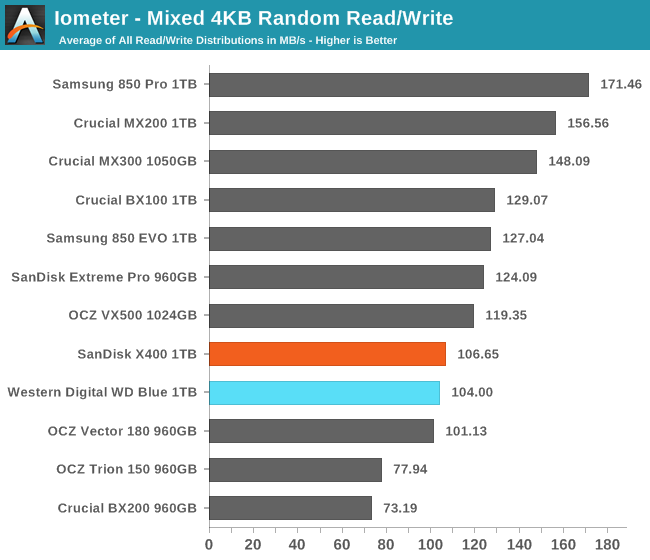
Like the SanDisk X400, the WD Blue performs better on the mixed random I/O test than competing planar TLC drives and about the same as the slowest MLC drives.
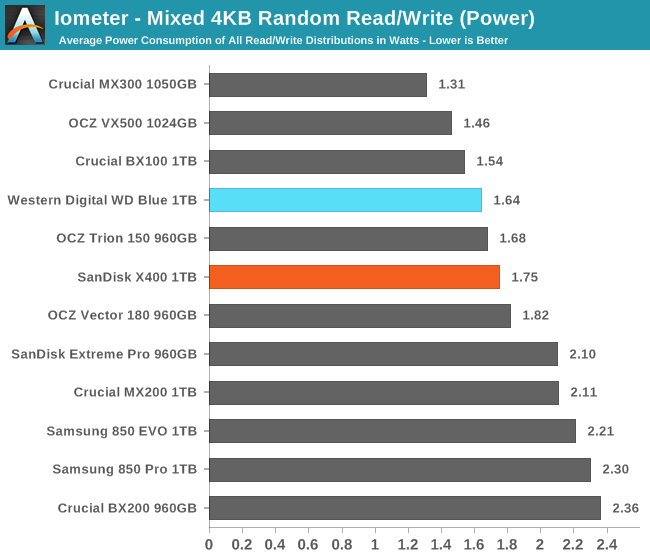
The WD Blue once again slightly raises the efficiency standards for planar TLC, but is still nowhere near as efficient as 3D TLC or MLC.
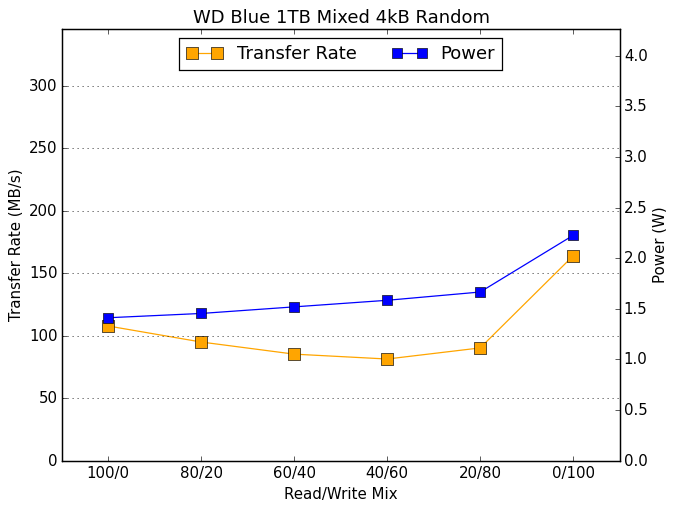 |
|||||||||
The WD Blue starts the mixed random I/O test with a pretty good random read speed, but performance declines as writes are added to the mix until near the end of the test, where the jump in the last segment of the test is not as large as what most drives experience.
Mixed Sequential Read/Write Performance
The mixed sequential access test covers the entire span of the drive and uses a queue depth of one. It starts with a pure read test and gradually increases the proportion of writes, finishing with pure writes. Each subtest lasts for 3 minutes, for a total test duration of 18 minutes. The drive is filled before the test starts.
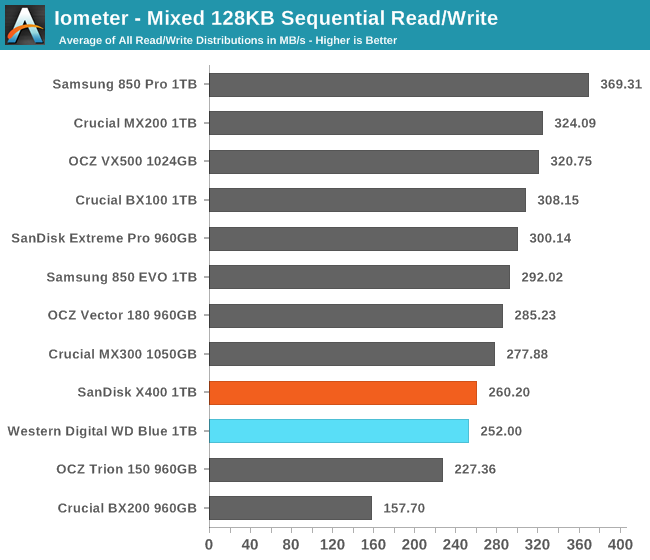
The WD Blue performs above average for a planar TLC SSD on the mixed sequential I/O test, but is not competitive with MLC or 3D TLC.
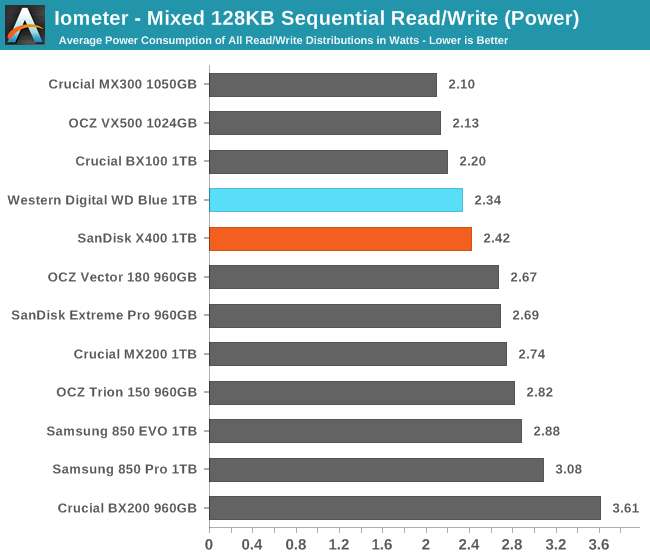
In absolute terms the WD Blue has pretty low power draw on this test, but the efficiency is not close to setting a record.
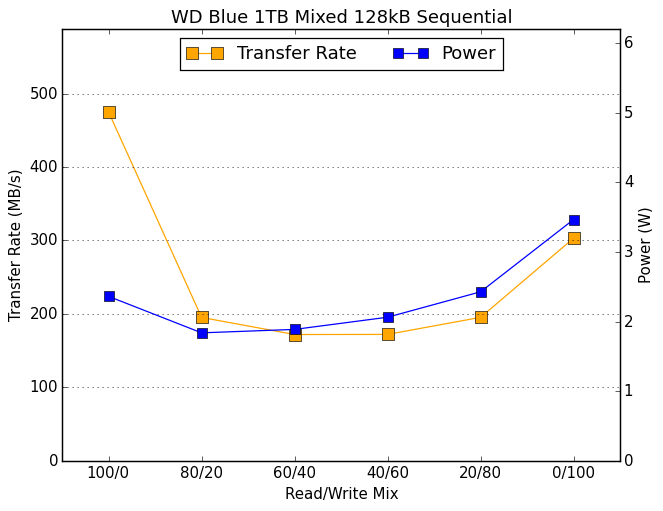 |
|||||||||
The WD Blue's U-shaped performance curve across this test is fairly typical, but the dropoff at the beginning is relatively steep and the minimum is a bit on the low side.










75 Comments
View All Comments
Magichands8 - Wednesday, October 12, 2016 - link
That's funny you should say that since I've been noticing it for years. Every single time I move around large files to reorganize or back them up, in fact. But I'm sure that I'm the only non-video editing person on the planet who doesn't use his computer exclusively for reading and writing tiny text files and browsing the internet. I'm also sure that I'm the only who would have a problem paying a premium for very low capacity devices just so I could experience their limitations.Michael Bay - Thursday, October 13, 2016 - link
Oy vey, nobody in the market cares for my special snowflake wants, it`s anudda shoah!mapesdhs - Friday, October 14, 2016 - link
You need more explosions in your posts. ;Dbeginner99 - Wednesday, October 12, 2016 - link
It's cheap but not really excitingly cheap. Doesn't really beat the aged MX200 which also comes with MLC NAND which I deem superior to this TLC low-end crap. Only advantage this has over MX200 is price. Good for a cheapo game-drive maybe but would avoid as OS drive.Arnulf - Wednesday, October 12, 2016 - link
Ewww, 15nm planar TLC along with WD branding.JimmiG - Wednesday, October 12, 2016 - link
I remember the time when the 850 Evo was considered a "budget" SSD. Now it's almost a high-end SSD.haukionkannel - Wednesday, October 12, 2016 - link
And the price of evo is still going up. Hopefully there will be stop to it eventually.Impulses - Wednesday, October 12, 2016 - link
It's not really going up, just plateau'ing hard, sales might be happening slightly less frequently lately, I dunno... I do remember seeing the 1TB under $300 a number of times but it's mostly been just over $300 for well over a year.I paid $320-ish for two back in July-August 2015 when they were first starting to get close to $300. It's still faster than the field and brand alone is probably sustaining their ability to charge a premium.
mapesdhs - Friday, October 14, 2016 - link
Maybe it depends on where you live, but the 850 EVO went up a lot where I am (UK). Back in Jan this year the 250GB was 53 UKP, now the same model is 85 UKP. Samsung is exploiting demand for what used to be a well priced, reliable product to give the model a premium image that's pushing its cost far above where it really should be. This has happened before, eg. when the 830 series shot up in early 2013 after strong demand, which helped ensure all other brands didn't lower their prices.TheinsanegamerN - Friday, October 14, 2016 - link
what HASNT shot up in price in the UK post-Brexit vote?